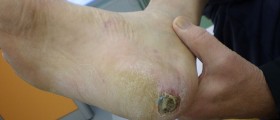
Toenail infections can be very persistent, and for those who decide to treat them naturally, without synthetic medications, vinegar is one of the best options.
About toenail infections
The most common type of toenail infections is a fungal infection. Fungal infections are caused by fungi of the group called Dermatophytes. Fingernails can also be affected by these infections, but toenail, especial big toe infections, are far more common.
The infection usually starts as a small spot on the nail that eventually spreads. This infection is transmittable and it can easily spread to other toes and other parts of the body.
The causes of the toenail infection include poor personal hygiene, infection by a person who already has Dermatophytes, poor-fitting shoes, synthetic footwear, especially socks, and injuries that make the skin and the nail prone to infections.
Toenail fungal infections can be classified into three groups- distal subungual onychomycosis, white superficial onychomycosis and proximal subungual onychomycosis . Onychomycosis is the medical term for fungal nail infections.
Symptoms of fungal infection of the toenail include color changes of the nail, which usually turns yellow or brown and eventually even black, thickening of the nail, breakage, splitting and a foul smell.
Vinegar treatment for toenail infections
Vinegar is one of the most popular and most effective home remedies for fungal infections. Vinegar is a diluted acetic acid produced by oxidation of any liquid containing alcohol. Because it is acidic, it helps kill bacteria, fungi and other harmful organisms, which do not respond well to acidity.
Treatment with vinegar is most effective at the beginning of an infection. One way of using vinegar is to mix it with water and to use that solution for soaking the feet. The rate is one part vinegar and two parts lukewarm water. Feet should be soaked twice a day for 20 minutes, after which they are thoroughly dried. Hands should be carefully washed before and after soaking.
Another way is to wipe infected toenail with a cotton ball well soaked in a mixture of equal parts of vinegar and hydrogen peroxide. A drop or two of vinegar can be applied with a dropper under the affected nail too.
As the nail grows, it should be trimmed as short as possible. Proper hygiene is necessary, as well as wearing comfortable shoes and cotton-only socks.
The only drawback of vinegar treatment for toenail fungal infections is that it takes a while. It needs around six months for effective results, but the response can vary form person to person.

















Your thoughts on this
Loading...